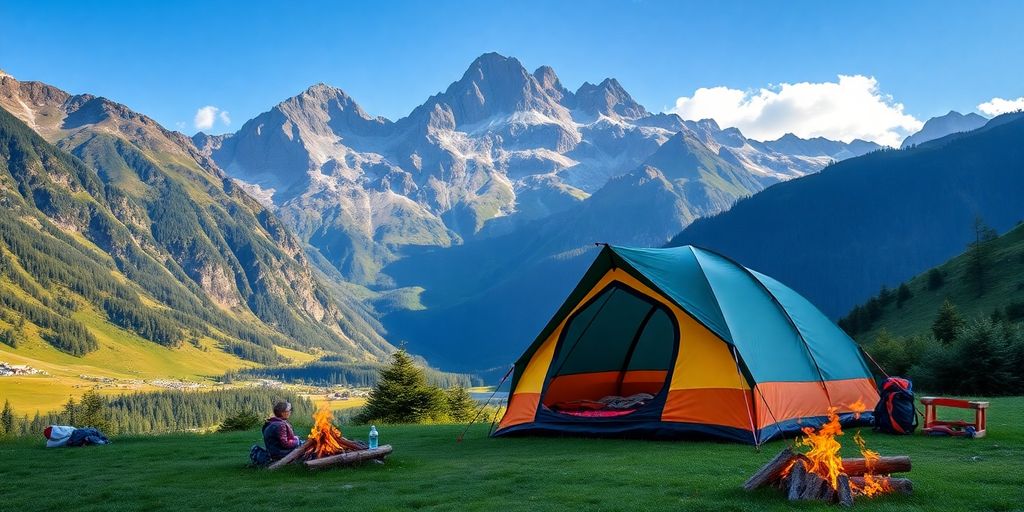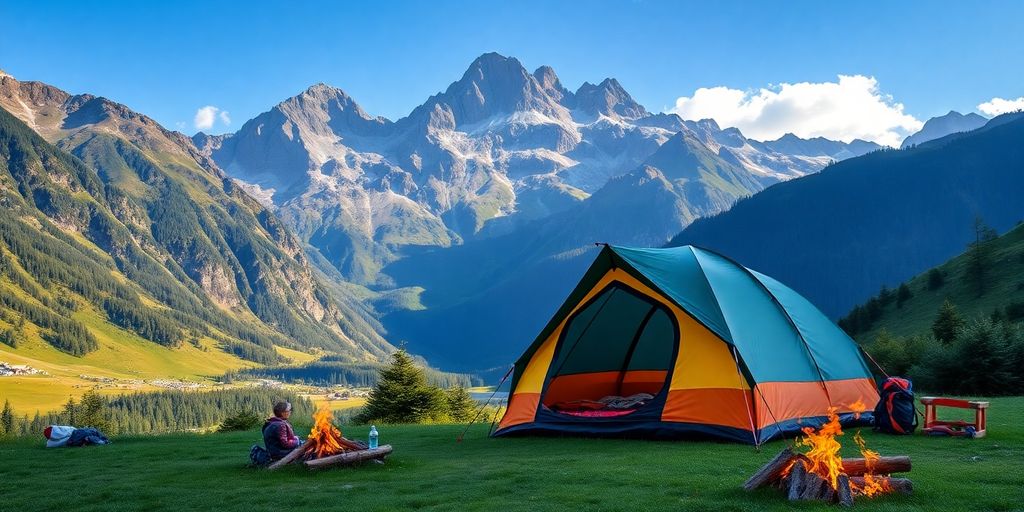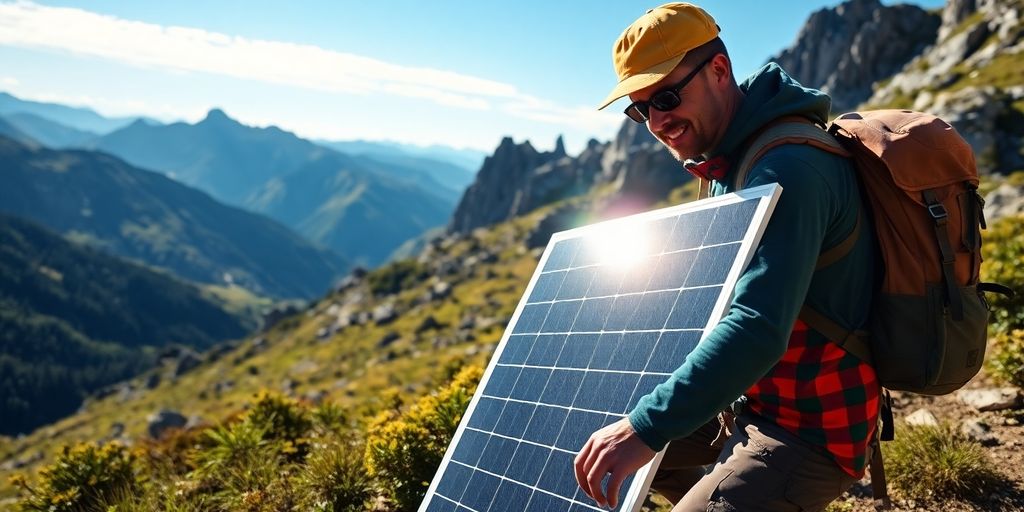Discover the Best Backpacking Tent for Your Next Adventure in 2025

If you’re planning a backpacking trip in 2025, finding the right tent can make all the difference for your adventure. With so many options out there, it’s easy to feel overwhelmed. You want something lightweight, durable, and capable of handling various weather conditions. In this guide, we’ll help you discover the best backpacking tent that suits your needs, whether you’re a beginner or a seasoned pro.
Key Takeaways
- Look for a tent that balances weight and space for comfort on the trail.
- Consider weather resistance to keep you dry and warm during your trip.
- Budget-friendly options can still offer good quality and durability.
- Easy setup is crucial for quick camping experiences.
- Different tents are better for specific environments, like rain or snow.
Choosing The Best Backpacking Tent

Alright, so you’re looking for a backpacking tent? Awesome! It’s a big decision, and honestly, there are tons of options out there. It can feel overwhelming, but don’t sweat it. We’ll break down the key things to think about so you can find the perfect shelter for your adventures. The right tent can make or break a trip, so let’s get it right.
Key Features To Consider
First off, think about what you actually need in a tent. Are you a solo hiker, or do you usually bring a buddy? How much space do you realistically need? Do you sprawl out in your sleep, or are you okay with being cozy? Consider these points:
- Capacity: Tent sizes are usually listed as "1-person," "2-person," etc. But keep in mind that these are often optimistic. A "2-person" tent might be tight for two adults with gear. I usually size up. If it’s just me, I’ll get a 2-person tent. If it’s me and my partner, we’ll get a 3-person tent. It’s worth the extra space.
- Freestanding vs. Non-Freestanding: Freestanding tents can stand up on their own without being staked to the ground. This is super handy if you’re camping on rock or hard-packed dirt where staking is tough. Non-freestanding tents are lighter but require stakes to pitch properly. It’s a trade-off.
- Number of Doors and Vestibules: More doors mean less climbing over your tentmate in the middle of the night. Vestibules are covered areas outside the tent where you can store your muddy boots and backpack. Trust me, you’ll want a vestibule.
Weight And Packability
This is a big one, especially for backpacking. Every ounce counts when you’re carrying everything on your back. Look for tents that are lightweight and pack down small. Ultralight tents are great, but they can also be more expensive and less durable. It’s all about finding the right balance for your needs. If you’re planning a thru-hike, picking the right tent for thru-hiking is a big decision.
Here’s a rough guide:
| Tent Type | Weight (per person) | Pack Size |
|---|---|---|
| Ultralight | Under 2 pounds | Very Compact |
| Lightweight | 2-3 pounds | Compact |
| Traditional | 3+ pounds | Can be bulky |
Weather Resistance
Think about the conditions you’ll be camping in. Will you be facing rain, wind, or snow? Look for tents with good waterproofing (measured in millimeters) and sturdy construction. Features like a full rainfly, taped seams, and strong poles are essential for staying dry and comfortable in bad weather. A tent’s ability to withstand the elements is a critical factor.
Don’t skimp on weather resistance. A cheap tent might save you money upfront, but it won’t be much fun if you’re stuck in a downpour with water seeping in. Read reviews and pay attention to what other backpackers say about the tent’s performance in different conditions.
Top Picks For Lightweight Tents
Best Ultralight Options
When it comes to backpacking, every ounce counts. That’s why ultralight tents are so popular. These tents typically weigh under 3 pounds for a two-person model, making them ideal for solo adventurers or those looking to minimize their load.
- NEMO Hornet OSMO
- Big Agnes Copper Spur
- Gossamer Gear The One
Choosing an ultralight tent often means making compromises. Durability might be less than heavier options, and the interior space can feel cramped. However, the weight savings can be significant, especially on long trips.
Compact Designs For Easy Carrying
Beyond just weight, packability is key. A tent might be light, but if it takes up half your pack, it’s not very practical. Look for tents that compress down small. Compact tents are a game changer for multi-day trips.
Consider these features:
- Foldable poles: Short pole sections allow for a smaller packed size.
- Compression sacks: These help squeeze the tent down to its minimum volume.
- Strategic design: Some tents are designed to distribute weight evenly when packed.
Performance In Various Conditions
Lightweight doesn’t have to mean flimsy. The best tents balance weight savings with weather protection. A good lightweight tent should handle rain and wind without issue. For example, when planning overlanding adventures in diverse climates, a tent’s ability to withstand varying conditions is paramount.
Here’s a quick guide:
| Feature | Importance |
|---|---|
| Waterproofing | Essential for rainy conditions |
| Wind resistance | Crucial for exposed campsites |
| Breathability | Prevents condensation inside the tent |
| Seam taping | Enhances weather protection |
Best Budget Backpacking Tents
Backpacking doesn’t have to break the bank. You can find perfectly capable tents that won’t empty your wallet. Affordable options have come a long way, offering decent performance and durability for casual backpackers. Let’s explore some of the best budget-friendly tents for your next adventure.
Affordable Yet Reliable
Finding a balance between price and quality is key. Budget tents often use heavier materials and simpler designs to keep costs down. This can mean a slight weight penalty, but it also translates to increased durability. Look for tents with sturdy fabrics and reliable zippers. Don’t expect the same level of performance as a high-end tent, but a good budget option will keep you dry and comfortable in moderate conditions.
Value For Money
When considering a budget tent, think about value. What features are most important to you? Do you need a lot of space, or is weight your primary concern? Read reviews and compare specs to find a tent that meets your needs without overspending. Sometimes, last year’s models are heavily discounted, offering excellent value.
Recommended Models Under $200
Here are a few tents that consistently receive good reviews for their affordability and performance:
- REI Co-op Trail Hut 2: A solid, reliable option with durable materials.
- Kelty Salida 2: Easy to set up and offers good weather protection.
- ALPS Mountaineering Lynx 1: A great choice for solo backpackers on a budget.
Remember to factor in the cost of a footprint (ground cloth) if it’s not included with the tent. This will help protect the floor of your tent and extend its lifespan.
Here’s a quick comparison of these models:
| Tent Model | Capacity | Weight | Price |
|---|---|---|---|
| REI Co-op Trail Hut 2 | 2 | 5 lbs 15oz | Around $229 |
| Kelty Salida 2 | 2 | 5 lbs 8oz | Around $170 |
| ALPS Mountaineering Lynx 1 | 1 | 4 lbs 7oz | Around $120 |
Durability And Longevity
Materials That Last
When you’re out in the wilderness, you need gear you can depend on. Tent materials play a huge role in how long your tent will last. Look for tents made with high-denier fabrics, especially for the floor, as this part takes the most abuse. Ripstop nylon or polyester with a durable water repellent (DWR) coating are good choices for the tent body and rainfly. Stronger materials might add a bit of weight, but the trade-off is worth it for extended durability.
Maintenance Tips
Taking care of your tent can significantly extend its lifespan. Here are a few things I’ve learned over the years:
- Always clean your tent after each trip. Wipe away dirt and debris with a soft sponge and mild soap.
- Make sure your tent is completely dry before storing it to prevent mildew.
- Store your tent loosely in a large bag instead of tightly packed to reduce stress on the fabric.
- Use a footprint or groundsheet under your tent to protect the floor from abrasion and punctures.
I once went on a trip where someone didn’t dry their tent properly. It was a mess of mold when they unpacked it for the next trip. Now, I always make sure my tent is bone dry before packing it away. It’s a small thing that makes a big difference.
Warranty Considerations
Checking the warranty before you buy a tent is a smart move. Most reputable tent manufacturers offer warranties against defects in materials and workmanship. A good warranty can save you money and hassle if something goes wrong with your tent. Read the fine print to understand what’s covered and for how long. Some companies offer limited lifetime warranties, while others have shorter terms. Keep your proof of purchase handy, just in case you need to make a claim.
Setting Up Your Tent
Ease Of Setup
Setting up your tent shouldn’t be a wrestling match with fabric and poles. Modern tents are designed for relatively easy setup, but some are definitely more user-friendly than others. Look for features like color-coded poles and clips, which can save you a lot of time and frustration, especially when you’re setting up in the fading light after a long day of hiking. Freestanding tents are generally the easiest, as they can stand on their own before you even stake them down. Semi-freestanding and non-freestanding tents require more attention to staking and tensioning, so they might take a bit longer to get right. Practice at home before you hit the trail!
Best Practices For Stability
Once your tent is up, making sure it’s stable is key for a good night’s sleep and protection from the elements. Here are some best practices:
- Stake it down properly: Use all the guylines and stake them securely into the ground at a 45-degree angle, away from the tent. This will maximize tension and prevent the tent from flapping in the wind.
- Choose your location wisely: Avoid pitching your tent in low-lying areas where water can accumulate, or under trees that could drop branches. A flat, slightly elevated spot is ideal.
- Tighten everything up: After staking, go around and tighten all the straps and buckles to ensure the tent is taut and wrinkle-free. This will improve its weather resistance and prevent condensation buildup.
Taking a few extra minutes to properly secure your tent can make a huge difference in its performance and your comfort. A well-pitched tent is more resistant to wind, rain, and snow, and it will also be quieter and more comfortable to sleep in.
Common Mistakes To Avoid
Even with a great tent, it’s easy to make mistakes that can compromise its performance and your comfort. Here are some common pitfalls to watch out for:
- Forgetting the footprint: A footprint protects the bottom of your tent from abrasion and punctures, extending its lifespan. Always use one, even if you think the ground is soft.
- Over-tightening the guylines: Too much tension can stress the seams and poles, potentially causing damage. Tighten them just enough to remove slack and prevent flapping.
- Ignoring the weather forecast: Be prepared for the conditions you’re likely to encounter. If rain is expected, make sure the rainfly is properly installed and sealed. If wind is a concern, choose a sheltered location and use extra guylines.
Tents For Different Environments
Choosing a tent isn’t just about weight and space; it’s about where you’re planning to use it. A tent that’s great for a summer hike in the Rockies might be a terrible choice for a desert trip or a winter expedition. Let’s break down some key environmental factors and the tent features that matter most.
Best For Rainy Conditions
When rain is in the forecast, waterproofing becomes the top priority. Look for these features:
- High Waterproof Rating: Measured in millimeters (mm), this indicates how much water pressure the fabric can withstand. Aim for at least 1500mm for the floor and 1200mm for the fly.
- Full Coverage Rainfly: The rainfly should extend all the way to the ground to prevent rain from splashing up and under the tent.
- Seam Taping: All seams should be taped or sealed to prevent water from seeping through the needle holes.
- Bathtub Floor: This design raises the floor seams off the ground, creating a waterproof barrier.
Consider double-walled tents for rainy conditions. The separation between the inner tent and the rainfly helps reduce condensation, which can be a big problem when it’s wet outside.
Desert Camping Essentials
Desert camping presents a different set of challenges. Heat, sun, and sand are the main concerns. Here’s what to look for:
- Ventilation: Mesh panels and vents are crucial for airflow to keep you cool during hot days and nights.
- UV Resistance: The tent fabric should be treated to resist UV degradation, which can weaken the material over time.
- Sand Resistance: Look for features like zippered storm flaps and tightly woven fabrics to keep sand out.
- Light Color: A lighter-colored tent will reflect more sunlight and stay cooler than a dark-colored one.
Snow And Wind Resistance
Camping in snowy or windy conditions requires a tent that can withstand extreme forces. Key features include:
- Strong Pole Structure: Look for tents with multiple poles and sturdy connectors to handle heavy snow loads and strong winds.
- Four-Season Design: These tents are built with heavier fabrics and fewer mesh panels to retain heat and block out wind.
- Guy-Out Points: Multiple guy-out points allow you to secure the tent tightly to the ground for added stability.
- Snow Flaps: These flaps around the base of the tent can be buried in the snow to prevent wind and snow from entering.
Here’s a quick comparison table:
| Feature | Rainy Conditions | Desert Camping | Snow/Wind Resistance |
|---|---|---|---|
| Waterproofing | High | Low | Moderate |
| Ventilation | Moderate | High | Low |
| UV Resistance | Low | High | Moderate |
| Pole Strength | Moderate | Low | High |
Comparing Popular Brands

Big Agnes vs. REI
When it comes to backpacking tents, Big Agnes and REI are two giants in the industry. Big Agnes is known for its innovative designs and lightweight materials, often pushing the boundaries of what’s possible in tent construction. Their Copper Spur line is a favorite among backpackers for its spaciousness and low weight. REI, on the other hand, offers a broader range of products, including tents that cater to various budgets and needs. REI tents are often praised for their durability and value, making them a solid choice for those who want a reliable tent without breaking the bank.
Here’s a quick comparison:
| Feature | Big Agnes | REI |
|---|---|---|
| Key Strength | Lightweight design, innovation | Durability, value |
| Price Range | Higher end | Mid-range to higher end |
| Target Audience | Experienced backpackers, weight-conscious | Beginners to experienced, budget-aware |
Nemo Innovations
Nemo Equipment has carved out a niche for itself with its focus on thoughtful design and user-friendly features. They’re not afraid to experiment with new materials and construction techniques, resulting in tents that are both functional and aesthetically pleasing. One thing that sets Nemo apart is their attention to detail, such as integrated lighting systems and unique pole configurations that maximize interior space. If you’re looking for a tent that’s a little different from the norm, Nemo is definitely worth considering. For example, the NEMO Hornet Elite Osmo is a great choice.
MSR Features
MSR (Mountain Safety Research) is renowned for its rugged and reliable gear, and their tents are no exception. MSR tents are built to withstand harsh conditions, making them a popular choice for mountaineering and winter camping. Their focus is on performance and durability, often using heavier materials and reinforced construction to ensure that their tents can handle whatever Mother Nature throws their way. While they may not be the lightest option on the market, MSR tents offer peace of mind in challenging environments. MSR tents are a great choice for desert camping essentials.
Choosing between these brands often comes down to personal preferences and priorities. Consider what’s most important to you – weight, durability, price, or innovative features – and then explore the specific models that each brand offers to find the perfect fit for your next backpacking adventure.
Wrapping It Up
So, there you have it! Picking the right backpacking tent can feel like a lot, but it doesn’t have to be. Whether you’re just starting out or you’ve been on the trails for years, there’s a tent out there that fits your needs. Remember to think about how many people will be sleeping in it, the weather you might face, and how much weight you’re willing to carry. With the options we’ve covered, you should be ready to hit the trail with confidence. Happy camping, and may your next adventure be filled with great memories!
Frequently Asked Questions
What should I look for in a backpacking tent?
When choosing a backpacking tent, consider its weight, size, weather resistance, and how easy it is to set up.
How much should I spend on a backpacking tent?
You can find good backpacking tents for under $200, but prices can go much higher for premium models.
What is the best tent for rainy weather?
Look for tents made with waterproof materials and a good rainfly to keep you dry during storms.
How do I clean and maintain my tent?
Keep your tent clean by wiping it down after use and storing it dry. Avoid using harsh chemicals.
Can I use a backpacking tent in winter?
Yes, but make sure it’s designed for cold weather with features like a strong frame and good insulation.
What are the differences between single-wall and double-wall tents?
Single-wall tents are lighter but less breathable, while double-wall tents have better ventilation and are more weather-resistant.








Responses